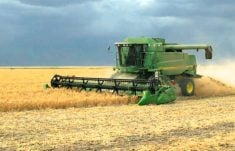CHICAGO (Reuters) — The U.S. Department of Agriculture’s first 2014 acreage estimates for the eight major crops shocked veteran grain analysts as they expected spring plantings to be up by several million acres from 2013, not down.
At it’s annual Agricultural Outlook conference in Washington on Thursday, USDA forecast a total of 253.8 million acres would be planted to corn, other feed grains, wheat, rice, cotton, and soybeans in 2014-15, down 1.7 million from 2013.
Given the 8.3 million acres cropland that went unseeded in 2013 as heavy rains, especially in northern states like Minnesota and Iowa, prevented plantings and the 1.5 million acres released from the conservation reserve program last autumn, analysts are asking: Where are all the acres?
Read Also

Arlene Dickinson says recent trip to Asia opened her eyes to new trade opportunities
Arlene Dickinson says Canada must take up decades-old suggestions to support the agriculture and food sectors
“It is a head scratcher,” said Don Roose, president of farm advisory U.S. Commodities. “We had over a million acres come in from CRP — where are they going to go? What’s going to happen to prevent acres from last year?”
“You could make a case that acres should be up seven to eight million, here they are down a million,” Roose added. “It’s probably going to be one of the big debates out of this outlook meeting.”
A rise in soybean, cotton and rice plantings in 2014 was met by an unexpected total decline in corn, other feed grains and wheat, USDA forecast at its annual outlook forum now in its 90th year, which kicks off the start of the U.S. planting season.
Corn prices have fallen 30 percent since last June when the United States, the largest food exporter, recovered from the historic 2012 drought and had a record harvest last year.
“There is a feeling that lower prices result in lower planted area as farmers in the fringe production areas respond to lower prices. That’s USDA’s opinion — we’ll see,” said Dan Cekander, a grains analyst with Newedge USA in Chicago.
USDA is forecasting prices for most row crops to fall to the lowest level since 2009-10, expecting bigger yielding crops to weigh on prices. Corn, the largest U.S. crop, is projected to fall 60 cents to $3.90 a bushel.
Analysts said the biggest puzzle on Thursday’s numbers was how USDA was factoring in the huge number of acres that went unplanted in 2013 into their 2014 forecast.
“I don’t put much stock in what comes out of USDA in February but the trade talks about it and it moves the markets,” said Arlan Suderman, a grains analyst at Water Street Solutions in Peoria, Illinois.
Over the years, there is a tendency for a wide variance between USDA’s annual forum outlook numbers, its March planting survey and actual plantings as Mother Nature has a hand in the final numbers.
Suderman said he puts more weight on the government’s planting intention survey of some 85,000 farmers conducted over the next several weeks and released on March 31.
“The big questions are how much failed winter wheat acres we have in the Plains due to drought and winterkill, how many of those go to grain sorghum and soybeans,” said Suderman, adding that at recent farmer meetings he held in Minnesota and the Dakotas many were still undecided on final planting decisions.
“My guess is that the all-crop area will be higher because farmers love to grow, and are coming off record farm income years,” Rich Feltes, director of research with brokerage R.J. O’Brien, said.
“Their net worth is record high. They are going to shoot the marbles and go for max production,” Feltes added.
Last year farmers posted a record net farm income of $130.5 billion despite a sharp drop in corn prices the last half of the year.














